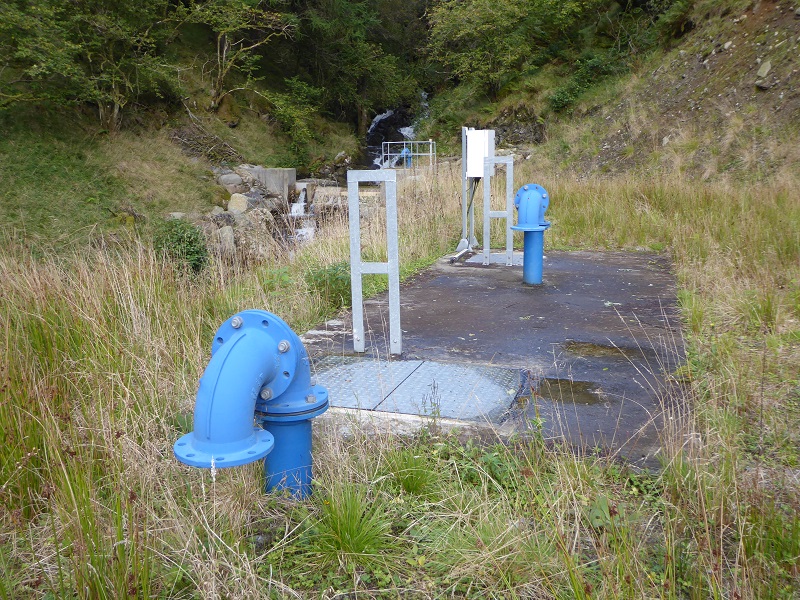
West of the Keltie Water hydro scheme, which has been shortleeted for a Scottish Planning quality award (see here), on the other side of the ridge and high ground running south from Beinn Each, are two further run of river hydro schemes. Both are situated in forestry/woodland on the Drumardoch and Ardchullarie Estate above Loch Lubnaig and I visited their intakes on the way back to Callander from Beinn Each on Saturday. Whether or not you believe the Keltie Water hydro scheme is good enough for a National Park, let alone deserving of a quality award, the finishing of these two schemes is a lot worse.
At the end of their blog on the Keltie Water hydro scheme (see here), the Loch Lomond and Trossachs National Park Authority made the following claim:
The ground has regenerated well because our National Park award winning guidance on renewable energy together with other good practice guidance provided by Scottish Natural Heritage and Scottish Environment Protection Agency was followed.
While at Keltie Water there is some evidence of that good practice guidance SPG-Renewables-final being disregarded (width of tracks for example) at the Ardchullarie and Anie schemes it appears to have been almost completely ignored.
The Ardchullarie hydro scheme
As with the Keltie Water scheme, I had blogged about the Ardchullarie scheme 18 months ago (see here) based on photos from Jane Meek and a subsequent FOI request I had made to the LLTNPA. I was interested to see what, if any improvements, had been made since then.
The Ardchullarie intake is located just off the path/track from Loch Lubnaig to Glen Ample, a popular route to Beinn Each and Stuc a Chroin. The walker’s path is now crossed by a new vehicle track, which was constructed across the hillside to connect existing forestry tracks to the burn. The LLTNPA has allowed this track to remain permanently despite its award winning policy that:
“It is expected that any new access tracks required for the construction will be fully restored unless there is overwhelming reason why they should be retained for the operational phase of the development.”
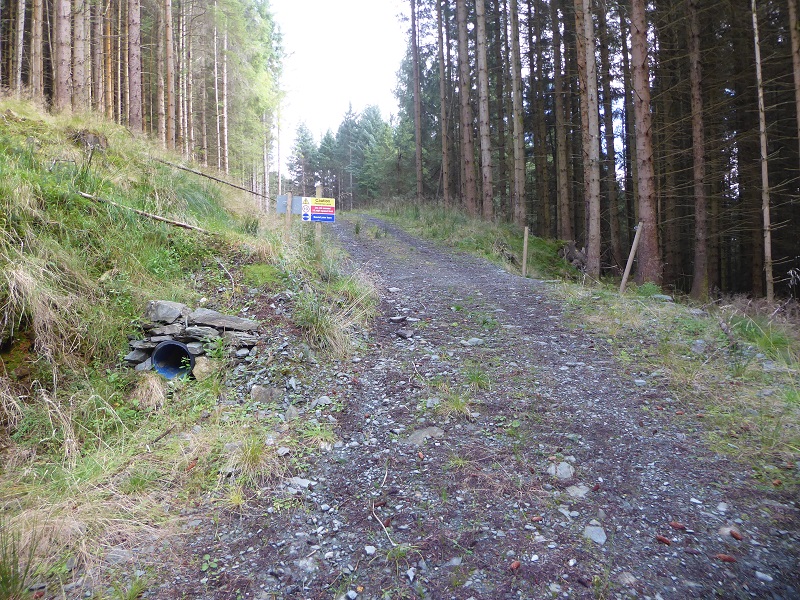
The section of new track where it crosses the walkers path has been well designed and finished. Just down from the walker’s path however is another matter:
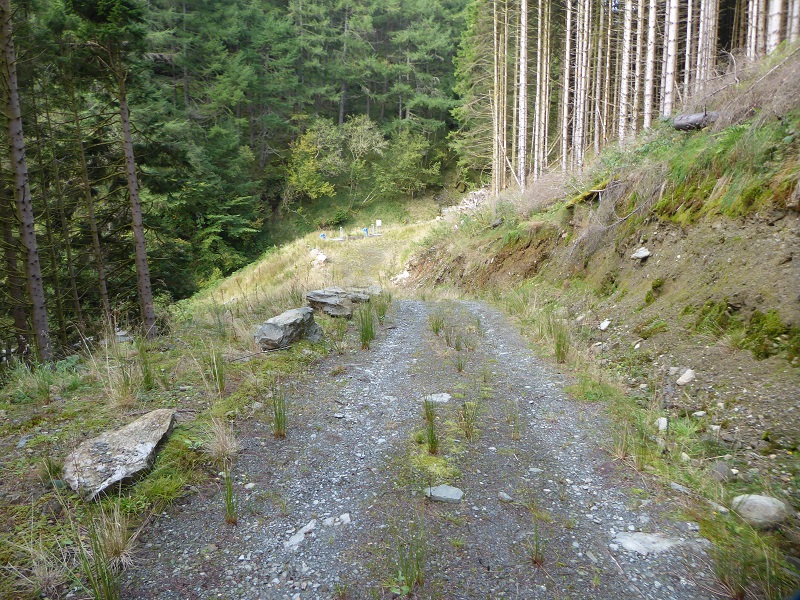
LLTNPA’s “award winning” best practice guidance states:
“If access tracks are to be retained for the use of light low pressure vehicles, the visual impact of these tracks should be minimised through downsizing the width, green track reinstatement methods and localised landscape mitigation such as planting and rock / boulder placement.”
AND
“Once the track is constructed the batters are bare earth surfaces that can scar the landscape, so in order to reduce their visual impact batters must be graded in order that re-vegetation can occur. Developers should follow best practice techniques:
- Minimise the length of the batter slope by avoiding steep hillsides.
- Ensure that the slope of the batter is shallow enough for vegetation to grow.
- Complete batters at the time of road construction, not retrospectively.
- Preferably cut and put aside turves during construction of the road and then place these on the
batters; or leave a prepared (cultivated) batter surface to assist re-vegetation. - Assist re-vegetation using appropriate techniques (for example the use of heather brash or native grass seed).
- Protect the batter from water erosion
You would struggle to find ANY evidence of that award winning good practice advice being implemented here.
While the bare slopes and ground photographed by Jane Meek in early 2017 have started to re-vegetate, what recovery has taken place appears to have happened naturally without any of the good practice techniques advocated by the LLTNPA. The revegetation is partial and the steep slope remains very vulnerable to erosion:
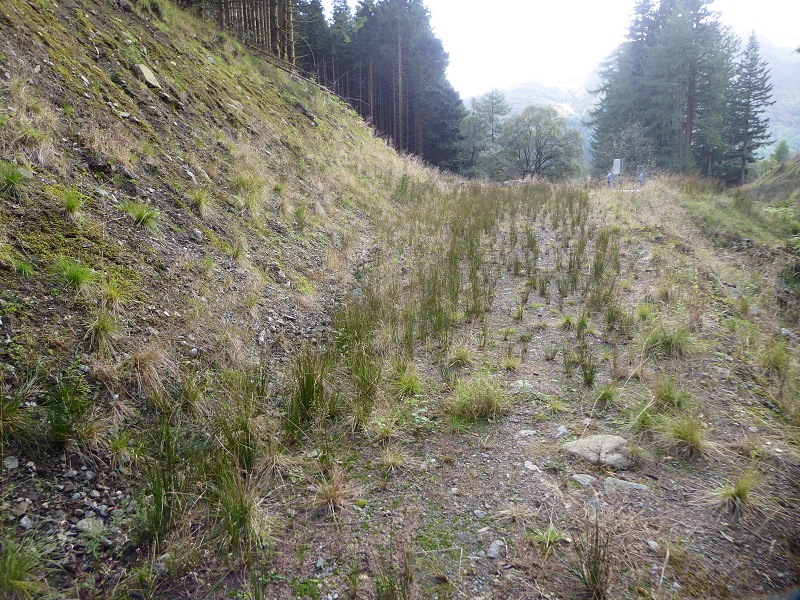
Had this section of temporary track been removed, instead of just being left to grow over, there would have been sufficient material to restore the landscape, including the oversteep uniform slope on the left.
“Good practice in soil management requires layers to be excavated and stored separately (e.g. subsoil, topsoil, growing layers / turf) so that they can also be replaced sequentially”
That’s not happened here. Instead, the abandoned track adds to the desolation created by industrial forestry practices.
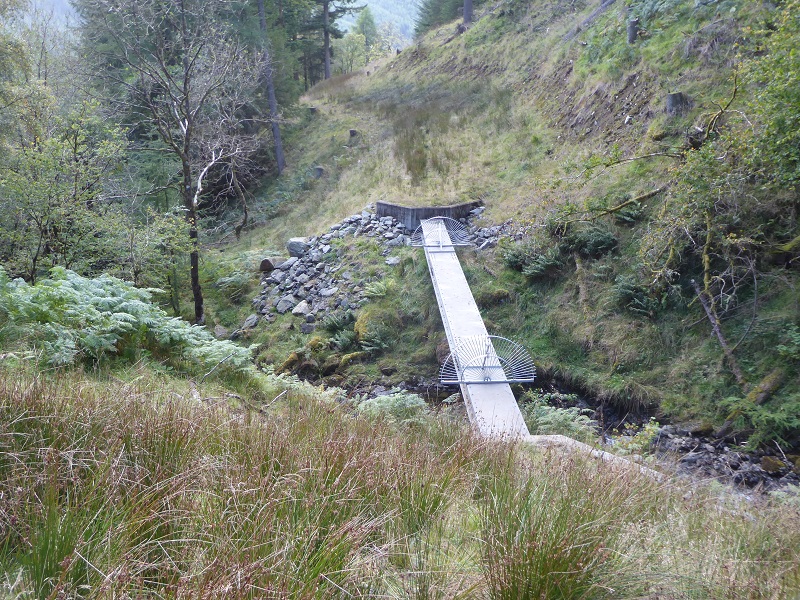
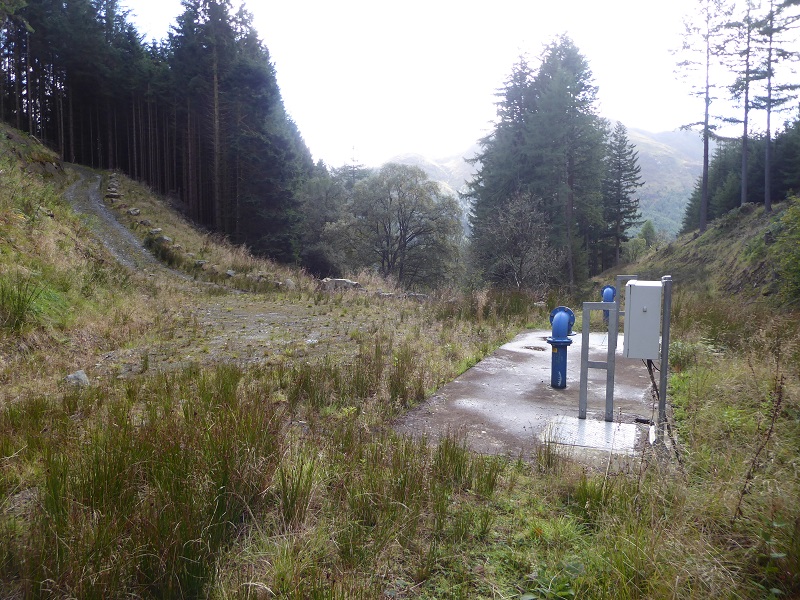
What most interested me most though about Ardchullarie was the intake dam and not just because of the LLTNPA’s guidance on wing walls, which as usual has been mostly ignored:
“If wing walls are required and concrete is to be used, choose a subdued colour which blends with the adjacent surroundings. A local source of boulders should be used to help screen the concrete structure. Be aware that concrete will stain on contact with water and that at periods of low water
linear striping can be an issue. Use stone cladding on exposed faces of the concrete to assist it to blend with its surroundings.”
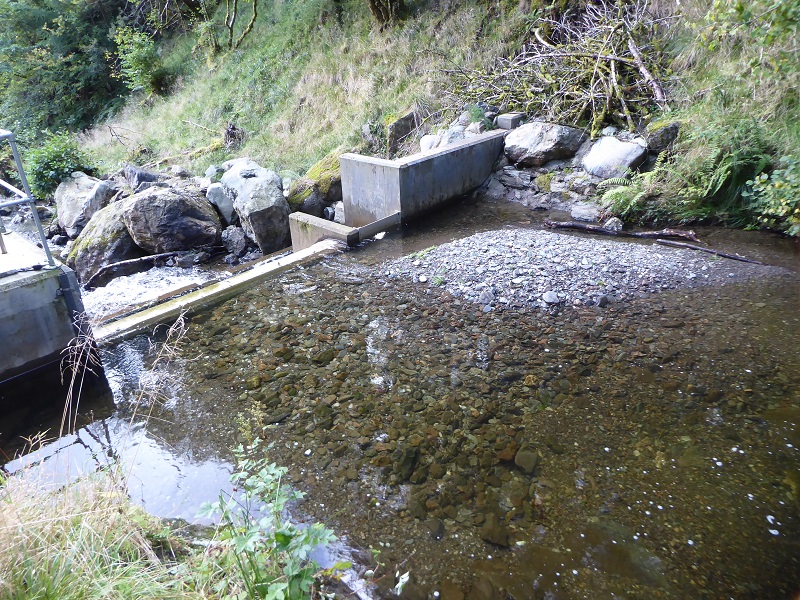
What was striking is how the intake pool is filling in:
Construction methods should ensure that there are no sedimentation impacts downstream of the in-stream works and that the design of the weir does not result in an accumulation of sediment upstream.” (LLTNPA Good Practice Guidance).
That would appear easier said than done. The intake is clearly forming a barrier to stones as they are eroded and swept down the burn. The impact of this, both on the ecology of these burns and on the functioning of the hydro, is something the LLTNPA should be commissioning research on. My suspicion is, however, that one reason access tracks are being retained and the temporary access track has not been restored is to enable diggers to be brought in to re-excavate intake pools every few years.
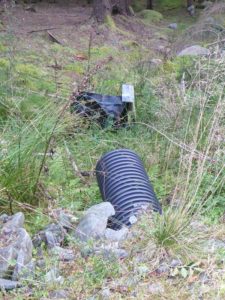
So what has this got to do with the Keltie Water hydro scheme?
Well, while some of the poor finishing at Ardchullarie (see left) is also evident at Keltie Water, on the whole the Keltie Water scheme is better than Ardchullarie which could never, in its current state, have been nominated for a quality award in planning. The big question therefore is why couldn’t some of that good practice at Keltie Water, such as the protruding metal pipes at the intakes being painted in natural colours, be applied here, particularly when the same agent, Campbell of Doune, was involved in both?
The answer, I believe, is connected to this scheme being located in industrial forestry where track construction standards pay little or no attention to landscape.
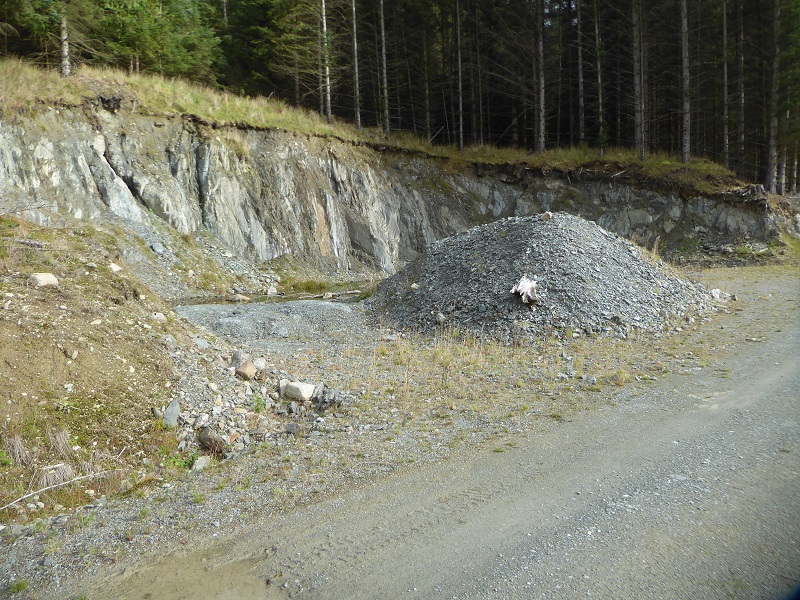
Past the new section of track heading south, there is an old forestry borrow pit which appears to have been used to source materials to build it. LLTNPA good practice guidance has again been totally ignored:
“As with the tracks, borrow pits must be re-graded sufficiently to form a slope where vegetation can
regenerate and grow. Any surplus materials such as rocks and boulders should be used to infill borrow pits prior to restoration.”
When I asked the LLTNPA under FOI in January 2017 for ALL the documents required by the LLTNPA when they granted the scheme planning consent (I have checked and believe 9 were required) I was sent just two, a revised Construction Method Statement (see here) by Campbell of Doune (who also designed the Keltie Water scheme and have been nominated as part of the Planning Quality Award for that scheme) and a site plan (see here) which shows the LLTNPA had agreed that the section of new track down to the header tanks could remain permanently. Other documents which had been required by the Planning Officer – and well done them for this – such as a landscape restoration plan and detailed track specification were notable by their absence.
I doubt therefore that most of the documents required under the planning consent were ever produced or provided; either that or the LLTNPA has lied to me in their response to their information request. So, why did this happen? I suspect it comes back to forestry and the LLTNPA having to process dozens of hydro applications in a short period of time without sufficient staff. What in effect they decided was not to bother enforcing planning conditions for run of river hydro schemes in forestry on the grounds that those areas were fairly well trashed anyway and to focus what limited resources they had on trying to make schemes in open country better. Hence the gulf between their good practice guidance – and indeed the original report from officers – and what has happened on the ground.
The Anie hydro scheme
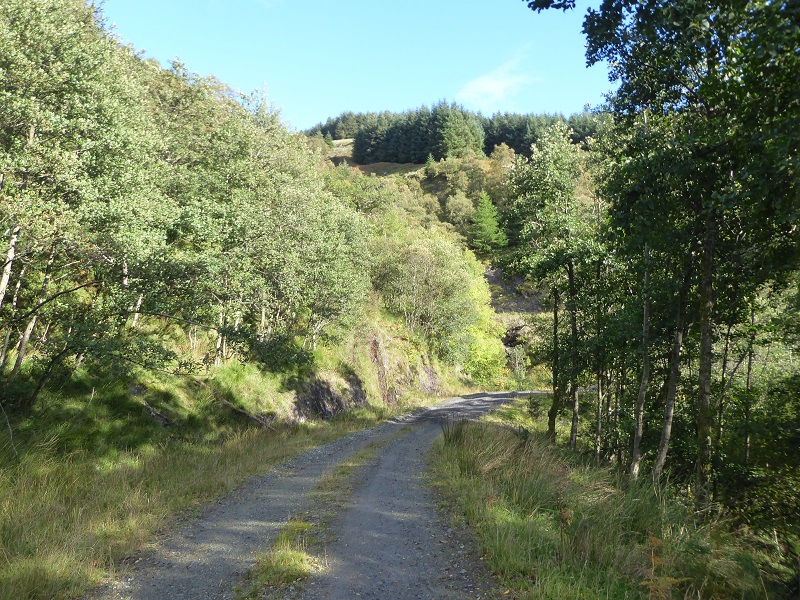
After 3km of mostly conifer plantation alongside the track south of Ardchullarie, its a relief to enter an enclave of native woodland.
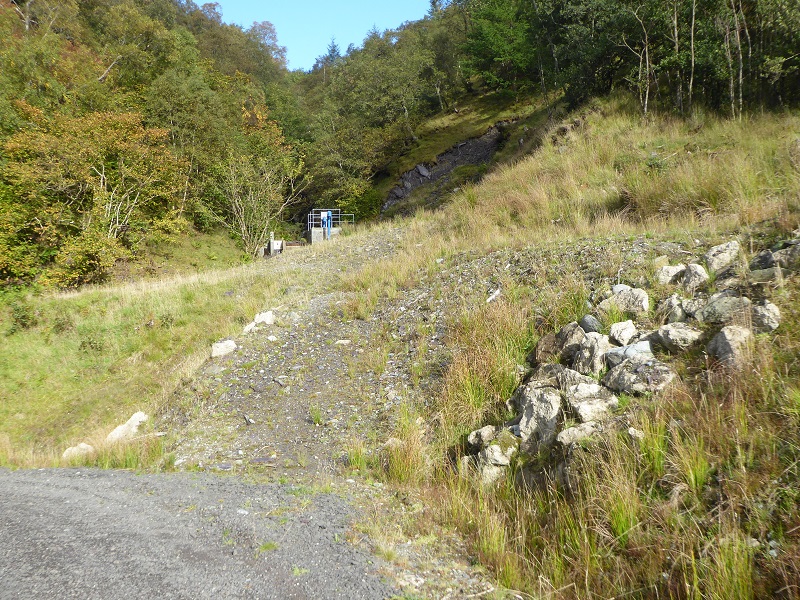
I had not visited the Anie burn hydro before but it demonstrates most of the same issues I have highlighted at Ardchullarie (the access track ran here previously so only a short length of construction track was needed) and how the LLTNPA is failing to enforce either planning conditions and its own award winning best practice guidance.
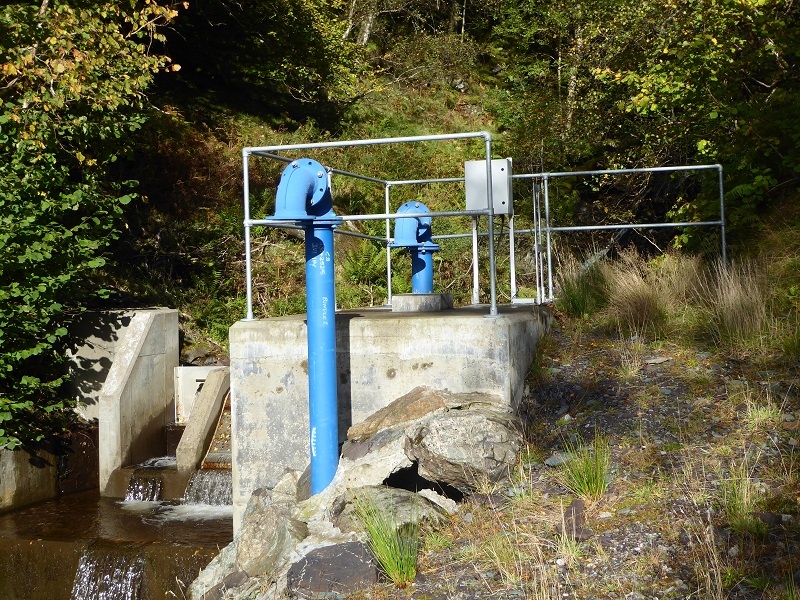
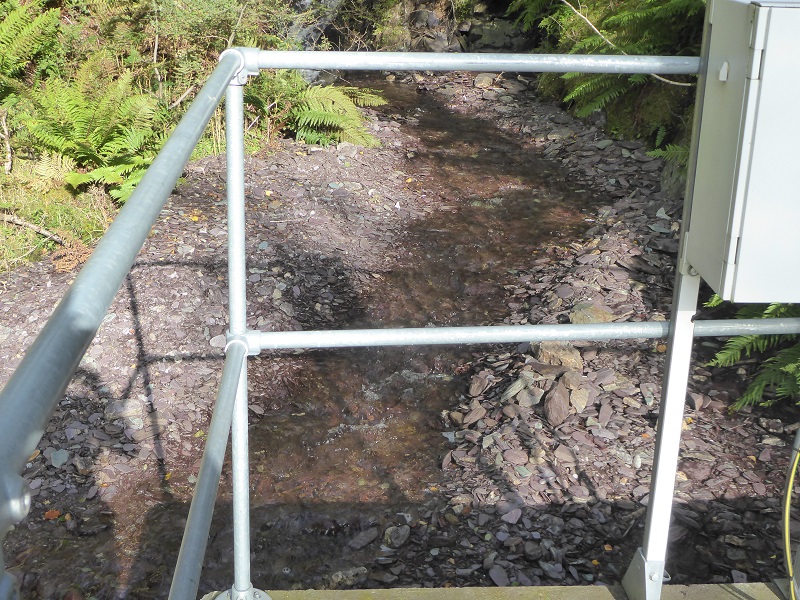
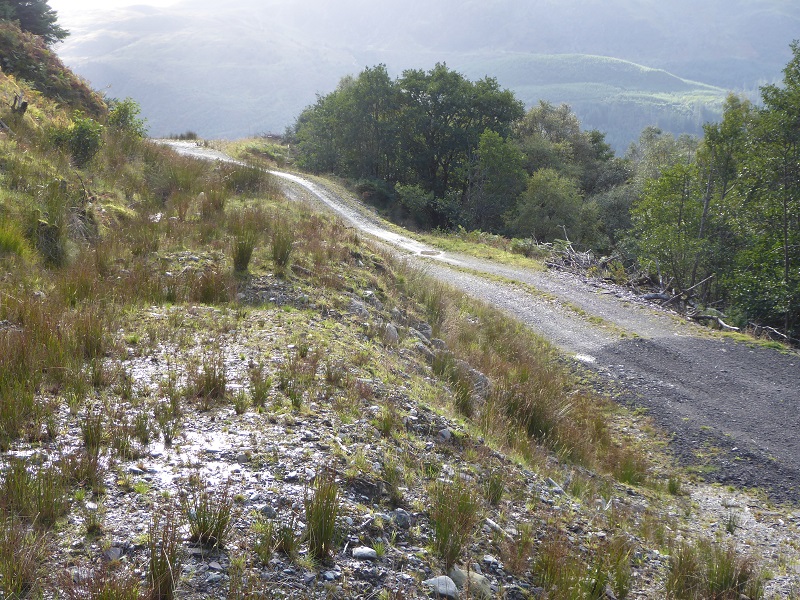
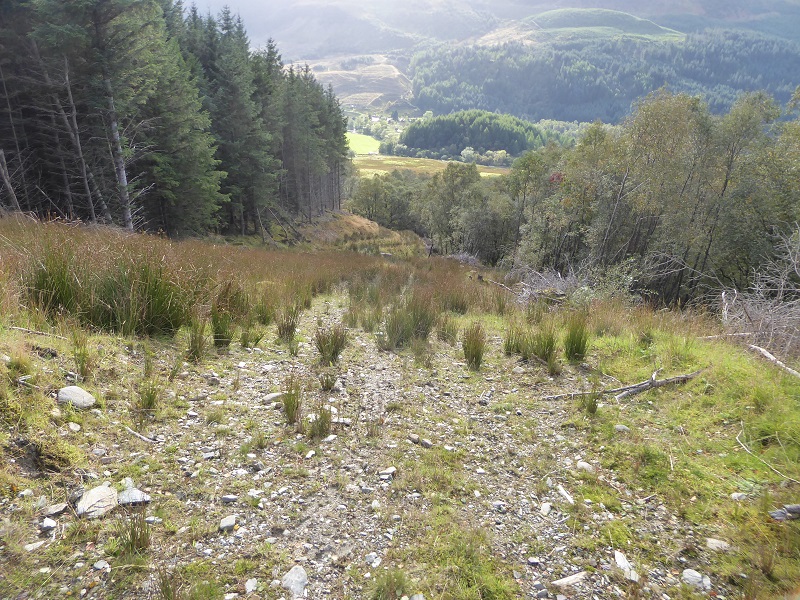
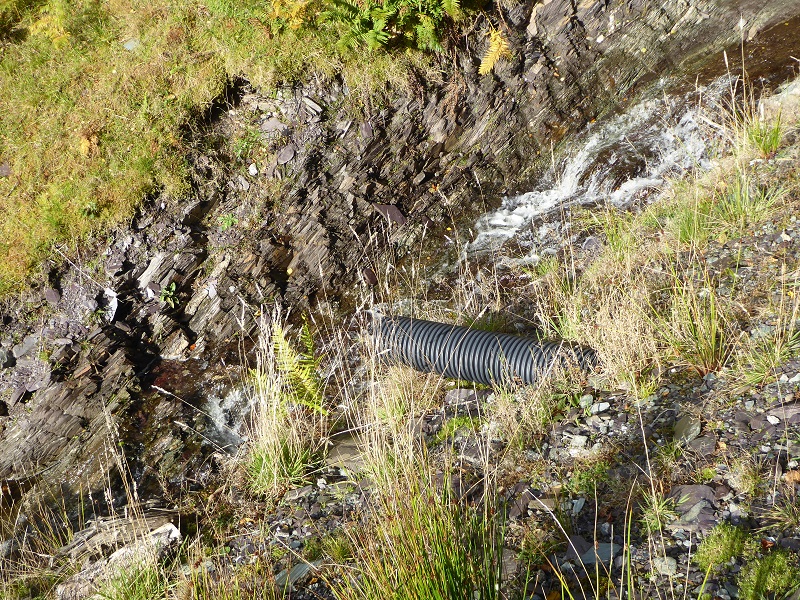
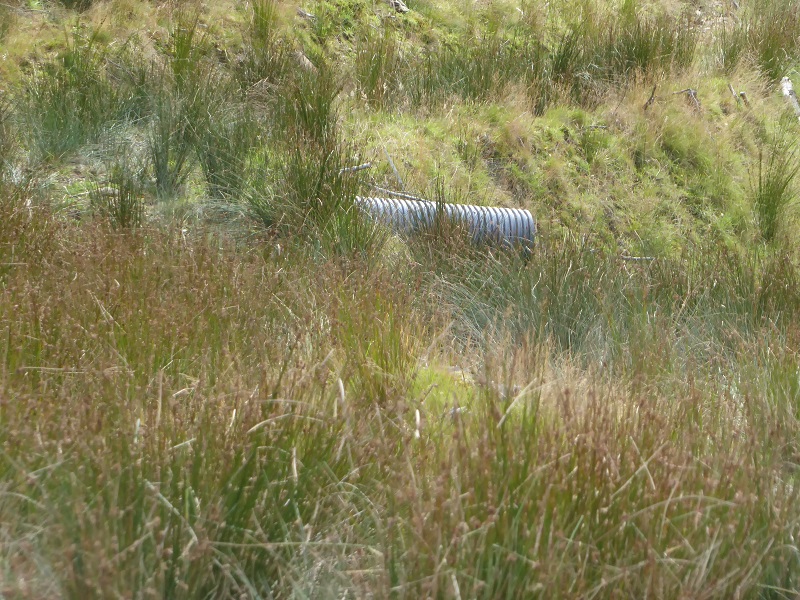
What needs to happen
The LLTNPA’s Best Practice Guidance on Renewables was pretty good – it needs updating and improved but it was well intentioned and addressed most of the issues which need to be considered in the design of hydro schemes. It dates from the time when Board Members were still in charge and had not delegated almost all planning decisions to staff (and thus all power to senior staff).
The core of the problem is that the LLTNPA has subsequently failed to follow and enforce its own guidance and appears to have abandoned doing so totally in certain forest areas.
“Attention to detail, and quality of finish make a huge difference to landscape and visual impact and time taken to get this right is a good investment.” (Good Practice Guidance)
It seems to me that the National Park’s failure to invest in the long term protection and enhancement of the landscape is fundamental not just to what it should be about but to how its performing.
Among the cut and pasted phrases which appears in the reports approving both these hydro schemes is the following:
“From experience with hydro schemes implemented in the Park to date, it is the construction phase that has the greatest impact on the Park’s landscape.”
That might be true if it was possible to restore the landscape fully or even if the LLTNPA was enforcing its own guidance but that is not happening and the long-term impacts of these hydro schemes are now outweighing the short-term impacts (which are soon forgotten).
Rather than nominating itself for Planning Quality Awards therefore, the LLTNPA should be commissioning an independent audit of how far its Planning Decisions have adhered to its own guidance, consider how that guidance could be improved in the light of experience and commission research into the long-term impact of hydro schemes, both on landscape and on ecology. Instead, LLTNPA senior staff are trying to distract attention from what is going on by promoting only what it has done best (and because its not that good are at the same time shooting themselves in the foot).
A properly functioning Board would be holding staff to account and trying to address what are real issues. That requires openness and honestly and a prepared to engage in real dialogue, qualities conspicuously absent in the way the LLTNPA currently conducts its business. I think only more pressure from the public and politicians will change this – so if you walk past a horrible hydro, please complain.
“The Scottish Awards for Quality in Planning are one of the Government’s most prestigious awards. They celebrate achievements in planning, right from the detail of processing through to the bigger picture of creating places which will become the legacy of our professionalism.” That says it all, you’d have thought – but nowhere in the “judging criteria” is there any mention of assessing how “quality planning” is actually achieved – this seems to be taken for granted, with “innovation” as the yardstick for how the organisation goes beyond this. Quality planning surely means independently reviewing what you do to confirm that you did it to the standards you published beforehand – that’s the definition adopted by the international standards bodies in most professional areas. It’s often called “quality control”. What appears to be lacking in LLTNPA is any sense of quality control. Without it, you’re right, they cannot possibly deliver a quality planning process. What they should be doing as a matter of routine is reviewing planning outcomes for each scheme – and creating lessons to learn from in then improving their process in future. It’s not rocket science! If they’re doing this, you’ve certainly not highlighted any evidence to support this.
Photos one and twelve…..Atmospheric Vent stacks from Chambers…….must have been designed/assembled by a pre Play School Group ! Although on second thoughts they might have done better !!
Why are the “Goose Necks” made from Ductile fittings, when a Stainless Steel 180 degree bend would be,lighter, longer lasting and more discrete ?
Yup…no pressure….hopefully……but why are the Flanges not completely bolted ? Incomplete bolting of a Flange was one of the contributing factors in the Piper Alpha Disaster !
And why no Non Return Valves on the ends ?